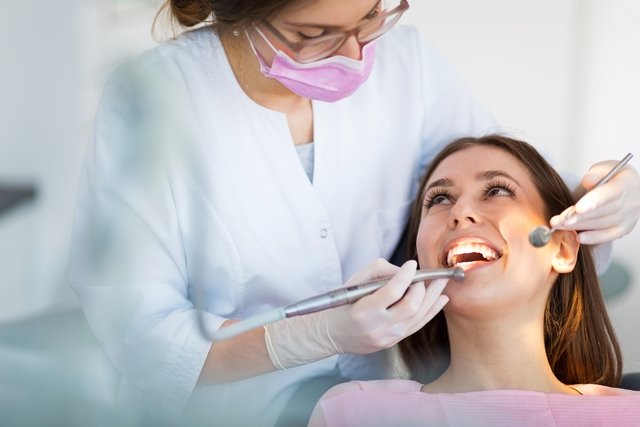Gingivitis is inflammation of the gums resulting in symptoms such as pain, intense redness, swelling, persistent bad breath and gum bleeding when brushing teeth, flossing or eating harder foods.
Gingivitis occurs due to the accumulation of bacterial plaque or tartar between the teeth and gums, most often due to poor oral hygiene. However, it can also be caused by vitamin deficiencies, normal hormonal changes during pregnancy or a side effect of medications, for example.
In most cases, gingivitis can be easily treated at home by reinforcing hygiene habits, however, when there is a lot of tartar, it is recommended that the dentist be consulted so that the bacterial plaque and tartar can be removed and thus , it is possible to reduce inflammation, avoiding complications.

Gingivitis symptoms
The main symptoms of gingivitis are:
- Swollen gums;
- Pain or intense redness in the gums;
- Teeth that appear longer than they really are because the gums are retracted;
- Increased sensitivity to very hot or cold foods;
- Persistent bad breath, which does not disappear even after oral hygiene;
- Bad taste in the mouth.
Furthermore, another common symptom of gingivitis is gum bleeding when brushing teeth, chewing harder foods or flossing, and spontaneous bleeding may also occur in more serious cases.
Gingivitis, when left untreated, can progress to periodontitis, which is an infection of the tissues that support the tooth, which can lead to tooth softening or even tooth loss. Know how to identify the symptoms of periodontitis.
Therefore, it is important that the dentist is consulted so that an evaluation can be carried out and the most appropriate treatment can be started to prevent complications.
Don’t ignore the signs your body is giving you!
How to confirm the diagnosis
The diagnosis of gingivitis is made by the dentist by observing the gums and teeth, which can be observed the presence of bacterial plaque or tartar, swelling and redness of the gums, in addition to touching the gums with instruments, easy bleeding can be observed.
In addition, the dentist must evaluate your health history, lifestyle habits and use of medications that may be leading to the appearance of symptoms.
Generally, no tests are necessary to confirm the diagnosis of gingivitis, however, if the dentist suspects periodontitis, a panoramic X-ray may be requested to assess bone loss in the affected region. Find out how panoramic X-rays are performed.
Possible causes
Gingivitis is caused by the proliferation of bacteria found naturally in the mouth, which leads to the development of bacterial plaque or tartar in the gingival groove, between the gums and teeth, resulting in gum inflammation and the appearance of symptoms.
The main factors that can contribute to the emergence of gingivitis are:
- More oral hygiene;
- Habit of smoking or chewing tobacco;
- Dry mouth or xerostomia;
- Poorly adapted restorations or crowns;
- Uncontrolled diabetes;
- Pregnancy, menopause or use of contraceptives;
- Use of medications, such as phenytoin, anticoagulants or calcium channel blockers;
- Weakened immunity due to HIV infection;
- Family history of gum disease.
Furthermore, nutritional deficiencies, especially vitamin C, a diet rich in sugar or excessive and frequent consumption of alcoholic beverages, can also increase the risk of gingivitis.
Other factors that can contribute to poor oral hygiene are the development of gingivitis, misaligned teeth, the use of fixed orthodontic appliances or difficulty brushing teeth due to motor changes.
People undergoing radiotherapy treatment for head and neck cancer, such as cancer of the mouth, larynx or pharynx, for example, or chemotherapy treatment, also have a higher risk of developing gingivitis.
How the treatment is carried out
Gingivitis treatment must be carried out under the guidance of a dentist, with the aim of reducing inflammation and preventing the development of complications, such as periodontitis.
Therefore, the dentist must carry out treatment with:
- Teeth cleaningcompletely removing all bacterial plaque and tartar accumulated between the teeth and gums;
- Assessment of whether a tooth is decayed or require some other treatment;
- Correct tooth brushing, about 30 minutes after meals, with a soft or electric toothbrush, and a fluoride toothpaste that has antibacterial properties. See how to brush your teeth correctly;
- Using dental floss dailyas it allows you to remove food accumulated between your teeth, preventing the formation of bacterial plaque and tartar.
Furthermore, in more advanced cases of gingivitis, the dentist may recommend the use of antibiotics, in the form of tablets, for about 5 days, and the use of antiseptic mouthwashes, to eliminate bacteria more quickly and allow the gums to heal.
Home remedy options for gingivitis
Some home remedies for gingivitis, such as clove tea or hydrogen peroxide solution, can help reduce the inflammation, pain or discomfort of gingivitis, relieving symptoms until a dentist is consulted. Find out how to prepare home remedies for gingivitis.
However, it is important to emphasize that home remedies can help alleviate symptoms initially, but they do not replace correct tooth brushing or the removal of plaque or tartar carried out by the dentist.
Check out more details about the treatment of gingivitis in the following video:

Sign up for our newsletter and stay up to date with exclusive news
that can transform your routine!
Warning: Undefined array key "title" in /home/storelat/public_html/wp-content/plugins/link-whisper-premium/templates/frontend/related-posts.php on line 12
Warning: Undefined array key "title_tag" in /home/storelat/public_html/wp-content/plugins/link-whisper-premium/templates/frontend/related-posts.php on line 13



